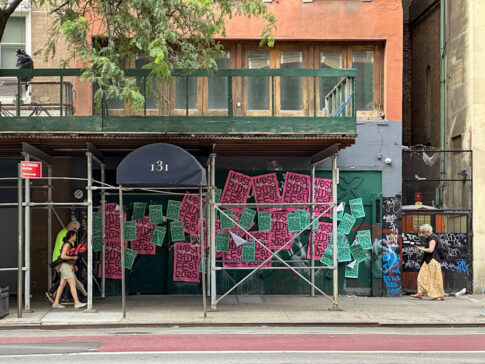
New York City's sidewalk sheds are getting a notable upgrade. Local Law 47 of 2025, signed into law this April and effective as of August 15, 2025, introduces meaningful changes to sidewalk shed requirements that will affect construction and facade projects across the city, with a focus on improved aesthetics and enhanced pedestrian experience while keeping public safety a priority.
What's Changed: Key Provisions at a Glance
New Color Options
The days of monotonous hunter green sheds are ending. Local Law 47 expands acceptable colors to include:
- Hunter green
- Metallic gray
- White
- For existing buildings (excluding full demolitions), any solid color that matches the building’s: facade, trim, cornice, or visible roofing colors
This expanded palette offers more flexibility for projects in historic districts or high-visibility locations where aesthetics are a concern.
Improved Pedestrian Experience
To make sidewalk sheds feel less like tunnels, the law increases the minimum ceiling height from 8 feet to 12 feet (unless that would block light, air, or egress like fire escapes). It also raises lighting standards from 1 to 1.5 foot-candles, with 5 foot-candles required near transit entrances, and introduces stricter efficacy standards for more energy-efficient lighting.
Alternative Protection Methods
The DOB is developing rules that may allow containment netting to be used as an alternative to full sidewalk sheds in areas with no public access or on building exposures adjacent to facade work areas.If adopted, this could offer a lighter, less obtrusive (and often less expensive) option for buildings undergoing minor exterior repairs.
Reduced Coverage Requirements for Certain Projects
Local Law 47 introduces a new exception to the typical sidewalk shed coverage requirements. For facade-only maintenance or repair on buildings that have no setbacks or projections above the second story (except AC units, lintels, or sills), sidewalk sheds are not required to cover areas of the sidewalk that are more than 40 feet away from the building along its length.
This change reduces how much of the sidewalk needs to be protected along the building’s frontage, which can help lower installation costs and minimize sidewalk disruption during routine facade work. That said, the Department of Buildings may still require extended coverage if a site presents unique hazards.
Strategic Considerations for Upcoming Projects
With Local Law 47 taking effect on August 15, 2025, now is a good time to review your project timelines and shed design plans.
- Projects that begin after August 15 will need to follow the new requirements.
- Projects already underway can continue under current rules, so if your current shed design is simpler or more cost-effective, it may be worth moving your schedule forward to avoid added height or lighting requirements.
While the new 12-foot shed height could increase costs, other changes in the law - like reduced shed coverage and the future option of containment netting - may offer savings depending on your building and scope of work.
Every project is different, and understanding how these changes apply to your specific situation can help you make the most efficient and informed decisions moving forward.
Preparing for Implementation
Immediate Actions
- Review upcoming projects for compliance with shed height, lighting, and color requirements
- Evaluate whether reduced shed coverage applies to your building
- Coordinate with design teams to develop color-matching strategies when appropriate
If your building is preparing for a Cycle 10 Facade Inspection Safety Program (FISP) filing or exterior work, now is a good time to revisit shed design, access planning, and potential cost impacts under these updated requirements.
The Department of Buildings is expected to release additional rules and guidance in the coming months, particularly regarding containment netting alternatives and potential mandatory design standards. We will continue to monitor these developments and provide updates as more information becomes available.
